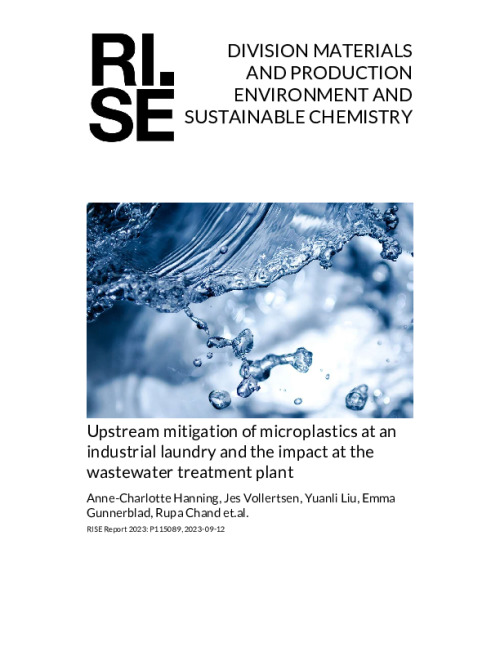Dispersion and fate models for microplastics from tyre and road wear
Microplastics from tyre and road wear constitute a large source of pollutants entering the natural environment, and the amounts of microplastics in different environments and their dispersion in nature are to a large degree unknown. In this literature review, models that can be used for dispersion and fate modelling of microplastics in the environment are presented together with related available modelling studies. Models for dispersion in air, stormwater and freshwater, soil and groundwater, oceans, as well as combined models for multiple environments are described.
There are several models available for modelling of microplastic dispersion in air. Hydrological models can be used for quantitative modelling of pollutant transport in watercourses and groundwater. Recently, new models have been developed for modelling of microplastics in watercourses and the ocean, although these do not focus specifically on tyre and road wear. No models have yet been developed for modelling of microplastics in soil, but here the dispersion is also slower.
Common for all models is that better emission estimates are needed as input, and more studies of how the microplastic particles characteristics (density, shape, size) and the various processes (aggregation, degradation, biofouling) in different media affect the transport.
Microplastics have been found in all environments: soil, water, air, the Polar Regions, and in organisms. Concentrations are expected to increase in all environments and there is limited knowledge on how microplastics disperse in nature. As emissions are expected to remain high, it is important to understand how microplastics are transported in the environment. In this report, dispersion and fate models for transport in air, freshwater, stormwater, soil, groundwater, and oceans, as well as combined modelling in multiple media are presented. The focus is on microplastics from tyre and road wear, which is one of the largest emission sources of primary microplastics. The emissions are mainly generated by tyre wear and, to a smaller degree, from asphalt containing polymer-modified bitumen and road markings, respectively.
A smaller fraction of the microplastic emissions from tyre and road wear is emitted to the atmosphere. There are many types of models available for air transport modelling, from simple plume and puff models which can be used tenth to hundreds of kilometres from the emission source to more advanced trajectory and grid models, which can be used at scales ranging from short distances from the source to globally. These models could be improved by increased knowledge of microplastic characteristics in air, such as size distribution, sedimentation speed, aggregation with other particles, degradation etc. Only a few studies on microplastic transport in air have yet been published.
The largest fraction of microplastic from tyre and road wear is emitted to soil and water, however it is not known how emissions are distributed between these media. Freshwater models include time-resolved hydrological models which describe the full hydrologic cycle, and water quality models which describe the transport in water only. Three-dimensional hydrodynamic models can be used to create a detailed description of the flow. All these models need to be validated against measurements, which are very scarce for microplastics. There are also simpler, steady-state models which can be used for a large number of watercourses, up to global scale. A few studies have looked at the amounts of microplastics that reach the sea, and how the particle characteristics influence the transport. To be able to describe this transport more accurately, knowledge of how microplastic characteristics (size, shape, density) influence the transport in both watercourses and lakes is needed. Knowledge on how the microplastics are affected by other processes, such as aggregation and biofouling, is also required.
Microplastics that end up on land surfaces can be transported slowly downwards and possibly reach the groundwater. Transport through soil and groundwater can be described by models for transport in porous materials, however these models are not adapted to microplastics, which have large variations in physical and chemical characteristics and frequently vastly different from the ideal particles which are often studied. There are also many processes which are not handled by these models, such as transport through cracks or turbation caused by farming or animals. Very few modelling studies of microplastics in soil have been performed.
Microplastics can be transported by different processes in the ocean, and different types of models are required to describe this. The ocean is often the final destination for microplastics from road and tyre wear, after transportation through soil, water and air and tend to settle in sediments close to coastlines.
There have been attempts to perform combined transport modelling through multiple media. The disadvantage is that they cannot yet be used to predict particle transportat.
In summary, there are so far few modelling studies describing microplastic transport in nature, and in particular microplastics from tyre and road wear. Research needs for modelling in all media include:
- More and better measurements. Measurement standards need to be developed for model validation. This is especially true for time-resolved freshwater models.
- More studies of microplastics characteristics (size, density, shape, chemical characteristics) and how the characteristics affects the transport in different media. VTI rapport 1061A 11
- More studies of how particles are transformed in nature (aggregation, biofouling, degradation etc.) and how this affects transport.
- Better emission data and data on how emissions are partitioned between soil, water and air.



